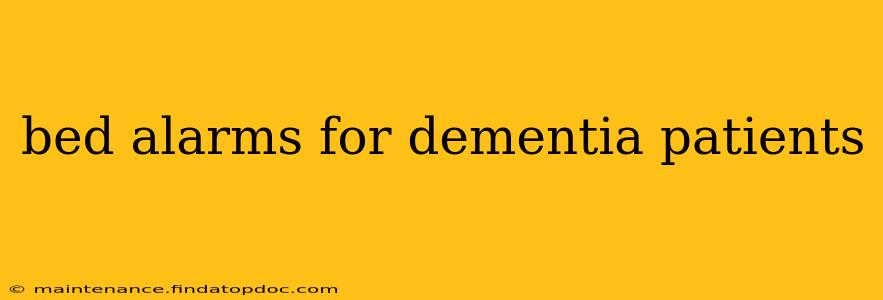Dementia significantly impacts a person's cognitive abilities, often leading to wandering and falls, particularly at night. Bed alarms designed for dementia patients offer a crucial safety net, alerting caregivers to attempts to get out of bed, potentially preventing injuries and ensuring peace of mind. This comprehensive guide explores the different types of bed alarms, their features, considerations for choosing the right one, and frequently asked questions.
What are the Different Types of Bed Alarms for Dementia Patients?
Several bed alarm types cater to the unique needs of dementia patients. These include:
-
Pressure-sensitive mats: These are placed under the bedsheet and trigger an alarm when pressure is removed from the mat, indicating the patient is getting out of bed. They are generally low-profile and unobtrusive.
-
Bed exit alarms with sensors: These use sensors placed under the mattress or on the bed frame to detect movement and trigger an alarm. Some models offer adjustable sensitivity to minimize false alarms.
-
Chair alarms: While not strictly bed alarms, chair alarms serve a similar purpose, alerting caregivers if a patient attempts to get out of a chair, preventing falls.
-
Combination alarms: Some systems offer a combination of pressure sensors and movement sensors for enhanced detection.
-
Wireless alarms: These provide greater flexibility and mobility compared to wired alarms. The receiver can be placed anywhere within range, allowing caregivers freedom of movement.
-
Alarms with monitoring features: Some advanced systems can track sleep patterns, movement throughout the night, and provide data for caregivers and medical professionals.
What Features Should I Look for in a Bed Alarm for a Dementia Patient?
Choosing the right bed alarm requires careful consideration of several key features:
-
Sensitivity: The alarm's sensitivity should be adjustable to avoid false alarms triggered by minor movements. Too much sensitivity can disrupt sleep, while too little can fail to detect attempts to get out of bed.
-
Alarm sound: The alarm sound should be loud and easily distinguishable but not jarring or frightening. Consider alarms with different sound options.
-
Alert method: Alarms can alert caregivers through sound, vibration, or both. Consider the caregiver's hearing abilities and the environment.
-
Ease of use: Both the patient and caregiver should find the alarm easy to use and set up. Simple operation minimizes frustration and ensures effective use.
-
Durability: Choose a durable and reliable alarm that can withstand frequent use and potential mishandling.
-
Portability: If the patient needs to be moved between rooms or locations, a portable alarm is essential.
How Do I Choose the Right Bed Alarm for a Dementia Patient?
Selecting the most appropriate bed alarm depends heavily on the individual's specific needs and the caregiver's circumstances. Consider these factors:
-
The patient's mobility level: The level of mobility will influence the type of alarm needed. A patient with limited mobility might only require a pressure mat, while a more mobile patient might necessitate a more sophisticated system.
-
The caregiver's needs: Consider the caregiver's hearing, mobility, and overall preferences when selecting the alarm type and alert method.
-
The sleeping environment: The size and layout of the bedroom will impact the type of alarm system that's most practical and effective.
-
Budget: Bed alarms range in price, from basic pressure mats to sophisticated monitoring systems.
What are the Potential Drawbacks of Using Bed Alarms?
While highly beneficial, bed alarms are not without potential drawbacks:
-
False alarms: Incorrectly calibrated sensitivity can lead to false alarms, disrupting sleep for both the patient and caregiver.
-
Patient discomfort: Some patients might find the alarm intrusive or uncomfortable, leading to resistance or attempts to disable the alarm.
-
Cost: Advanced systems can be expensive.
-
Dependency: Over-reliance on alarms can prevent caregivers from developing other strategies to manage nighttime wandering.
Are Bed Alarms Always Necessary for Dementia Patients?
Bed alarms are not always necessary for all dementia patients. Some patients may not exhibit nighttime wandering or mobility issues. However, for patients who do, bed alarms offer a significant safety net, preventing falls and injuries. A doctor or healthcare professional can help determine the necessity and suitability of a bed alarm for a specific individual.
Can Bed Alarms Help Prevent Falls?
Yes, bed alarms can significantly reduce the risk of falls in dementia patients by alerting caregivers to attempts to get out of bed. Early intervention can prevent falls and potential injuries.
What Other Safety Measures Can I Take for a Dementia Patient at Night?
Bed alarms are just one aspect of a comprehensive safety plan. Other strategies include:
- Well-lit hallways and bedrooms: Improved visibility reduces the risk of falls.
- Removal of tripping hazards: Clear walkways are crucial.
- Nightlights: Provide soft illumination without disturbing sleep.
- Regular medication review: Certain medications can increase the risk of falls.
By carefully considering the available options and implementing additional safety measures, caregivers can create a safer and more secure environment for dementia patients at night. Remember to consult with a healthcare professional to determine the best course of action for individual needs.
